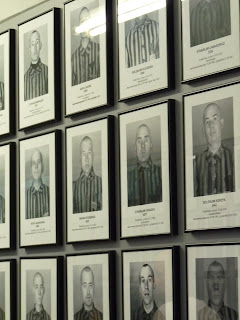Birkenau started to be constructed in 1941. Its scale dwarfs Aushwitz 1, it is said to be around ten times bigger.
Many of the original buildings were destroyed in an uprising in 1944 and as the Nazis fled in the face of the Soviet army, but you can still see where the chimney stacks were, stood in uniform lines, on and on and on, stretching as far as the eye can see.
As it became too time consuming and difficult to build from scratch, and more and more people poured into the camp, the Nazis used wooden horse stables to house them. They were designed to hold upto 52 horses. Here they held hundreds of human beings.
The heat inside these wooden shacks is unbearable in the middle of summer yet tortuously cold in the depths of winter. There is a small oven in each of the cavernous sheds but nothing that would offer any respite or comfort from the harsh, freezing mid winter.
Hygiene was non existent and the swampy ground of the camp meant that many people contracted malaria. Water was filthy and people also had lice, scabies and serious stomach problems.
Here you can see the communal toilet, opened twice a day, where prisoners had to file in, sit, do their business and get up again in a matter of minutes.
Completely against human nature, many did not even sit over a hole, they were in such a hurry they sat between them. The stench must have been unbearable.
The wooden slats in the sheds that pass as sleeping accommodation would not be fit for a dog let alone a human being. The people who could least fend for themselves, the old, the ill, would have one of the lower sleeping sections.
People above them, unwilling to leave the warmth, or ill themselves, would relieve themselves of any and all bodily functions where they lay. This is turn would make its way onto the people below, who were often too weak to move.
It is beyond comprehension how one group of people could dehumanise and demonise another section of humanity to the extent that they could subject them to this treatment.
For me the true, unabating horror was that it was not just the warped ideas of a single, homocidal maniac.
Hitler could never have perpetuated his crimes had it not been for a whole command structure beneath him who were eager to carry out his diabolical orders, and even came up with their own sickening ideas.
You do not ever want to believe mankind is capable of such evil, yet it happened. And it continues to happen. Human beings seem, above all, very good at hating.





















































